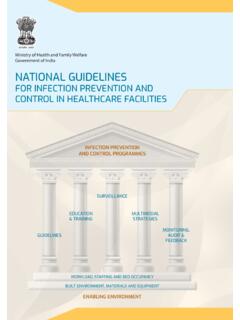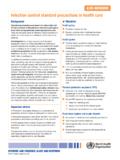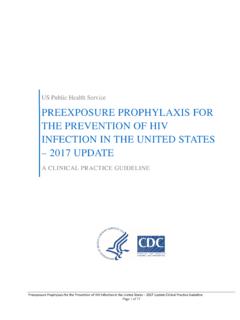Transcription of RECORD HIGH STDs THREATEN MILLIONS OF AMERICANS …
1 CDC FACT SHEETR eported STDs in the United States, 2017 High Burden of STDs Threatens MILLIONS of AMERICANS STDs are a substantial health challenge facing the United States. Many cases of chlamydia, gonorrhea, and syphilis continue to go undiagnosed and unreported, and data on several additional STDs such as human papillomavirus and herpes simplex virus, are not routinely reported to CDC. As a result, national surveillance data captures only a fraction of America s STD burden. However, the data presented in the 2017 STD Surveillance Report provide important insight into the scope, distribution, and trends in STD diagnoses in the country. STD Prevention Challenges Maintaining and strengthening core prevention infrastructure is essential to mounting an effective national response.
2 Limited resources make it challenging to quickly identify and treat STDs. More than half of state and local STD program budgets have been cut in recent years resulting in staff layoffs, reduced clinic hours, and increased patient co-pays that can limit access to essential diagnosis and treatment services. Antibiotics can cure chlamydia, gonorrhea, and syphilis. However, left untreated, they put men, women, and infants at risk for severe, lifelong health outcomes like chronic pain, severe reproductive health complications, and HIV. People who cannot get STD care remain vulnerable to short-and long-term health consequences and are more likely to transmit infections to others further compounding America s STD burden.
3 STDs in the Reach RECORD Highs TOTAL CASES IN 2017 2,295,739 Cases Reported in 2017: Chlamydia 1,708,569 Rate per 100,000 people: 529 Gonorrhea 555,608 Rate per 100,000 people: 172 Syphilis (primary and secondary) 30,644 Rate per 100,000 people: 10 Syphilis (congenital) 918 Rate per 100,000 live births: 23 Some Groups Are Uniquely Susceptible to the Health Consequences of STDs Chlamydia can cause lifelong damage to young women Chlamydia is the most commonly reported STD, with approximately million cases reported in 2017. Young women (ages 15-24) account for nearly half (45 percent) of reported cases and face the most severe consequences of an undiagnosed infection. Untreated STDs, like chlamydia and gonorrhea, put women at increased risk for pelvic inflammatory disease which may result in chronic pelvic pain, infertility, and potentially a life-threatening ectopic pregnancy.
4 It is estimated that undiagnosed STDs cause infertility in more than 20,000 women each 2018 pregnancy. It is estimated that undiagnosed STDs cause infertility in more than 20,000 women each Center for HIV/AIDS, Viral Hepatitis, STD, and TB Prevention Centers for Disease control and Prevention Troubling rise in syphilis among women and newborns While syphilis was nearly eliminated more than a decade ago, today it is on the rise. Diagnoses of primary and secondary syphilis, the most infectious stages of the disease, increased 76 percent from 2013 to 2017 (17,365 to 30,644). Increasing rates of syphilis among women has led to a sharp rise in congenital syphilis which occurs when syphilis passes from mother to baby during pregnancy.
5 More than 900 cases of congenital syphilis were reported in 2017, which resulted in a number of deaths and severe health complications among newborns. The disease is preventable through routine screening and timely treatment for syphilis among pregnant women. From 2016 to 2017, rates of syphilis increased: Among women By 21 percent From cases per 100,000 women in 2016 to per 100,000 women in 2017 Among newborns (congenital syphilis) By 44 percent From 16 cases per 100,000 live births in 2016 to 23 per 100,000 live births in 2017 STDs accelerating among men, particularly gay and bisexual men 9% Men accounted for more than 88 percent (26,885) of all primary and secondary syphilis cases in 2017.
6 Rates increased among men by 9 percent from 16 cases per 100,000 men in 2016 to 17 per 100,000 men in 2017. Gay, bisexual, and other men who have sex with men (MSM) accounted for 68 percent (17,736) of all cases where the gender of the sex partner is known in 2017 and over half of primary and secondary syphilis cases overall. * The term men who have sex with men is used in CDC surveillance systems because it indicates the behaviors that transmit infection, rather than how individuals self-identify in terms of their sexuality. If not adequately treated, syphilis places a person at increased risk for HIV. CDC estimates about half of MSM who have syphilis also have HIV. While gonorrhea increased among men and women in 2017, the steepest increases were seen among men (19 percent) from 170 cases per 100,000 men in 2016 to 203 cases per 100,000 in 2017.
7 Research suggests that reported cases of SEPTEMBER 2018 2 gonorrhea have increased among MSM in recent years. The rise in gonorrhea nationally is particularly alarming in light of the growing threat of drug resistance to the last remaining recommended gonorrhea treatment. While medication for gonorrhea has been available for decades, the bacteria has grown resistant to nearly every drug ever used to treat it. In the United States today, only one recommended treatment option remains a combination of the antibiotics azithromycin and ceftriaxone. What Can Be Done? Turning back the rise in STDs will require renewed commitment from all players: CDC uses national level information to detect and rapidly respond to evolving threats, trains frontline health workers, and provides STD prevention resources to state and local health departments.
8 State and local health departments should direct resources to STD investigation and clinical service infrastructure for rapid detection and treatment for people living in areas hardest hit by the STD epidemic . Providers should make STD screening and timely treatment a standard part of medical care, especially for pregnant women and MSM. They should also try to seamlessly integrate STD screening and treatment into prenatal care, as well as HIV prevention and care services to leverage PrEP clinical guidelines. Everyone should talk openly about STDs, get tested regularly, and reduce risk by using condoms or practicing mutual monogamy if sexually active. STD Screening is Critical: If you are sexually active, be sure to talk to your healthcare provider about STD testing and which tests may be right for you.
9 Women: If you are a sexually active woman younger than 25, or have risk factors such as new or multiple sex partners, you should request annual chlamydia and gonorrhea tests. If you have never been tested for HIV, you should request an HIV test. If you are a pregnant woman, you should request syphilis, HIV, and hepatitis B tests early in your pregnancy. If you are younger than 25 or have new or multiple sex partners, you should also request chlamydia and gonorrhea testing early in pregnancy. Gay and bisexual men: If you are a sexually active MSM, you should request tests for syphilis, chlamydia, gonorrhea, and HIV at least once a year. More frequent STD testing, such as every 3-6 months, is recommended for men at high risk, including men who have multiple sex partners.
10 If you are a member of the news media, please visit or contact the News Media Line at CDC s National Center for HIV/AIDS, Viral Hepatitis, STD, and TB Prevention: 404-639-8895 or Other information requests may be directed to the Division of STD Prevention ( ) or the CDC-INFO Contact Center: 800-CDC-INFO (800-232-4636). Source: This fact sheet summarizes data on chlamydia, gonorrhea, and syphilis published in CDC s annual report, Sexually Transmitted Disease Surveillance, 2017 (available at ). The data are based on state and local STD case reports from a variety of private and public sources. SEPTEMBER 2018 3














